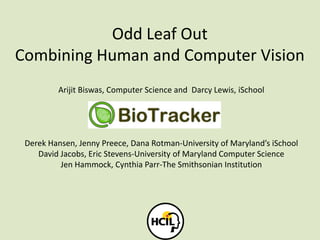Odd Leaf Out-HCIL Symposium 5.26.11
•Descargar como PPTX, PDF•
0 recomendaciones•267 vistas
Presentation given at the 2011 HCIL symposium on May 25, 2011.
Denunciar
Compartir
Denunciar
Compartir

Recomendados
Recomendados
Más contenido relacionado
Similar a Odd Leaf Out-HCIL Symposium 5.26.11
Similar a Odd Leaf Out-HCIL Symposium 5.26.11 (9)
Biotracker: Melding Human and Machine Capabilities to Document the World's L...

Biotracker: Melding Human and Machine Capabilities to Document the World's L...
TH301 - Start Thinking Like a Game Designer: An Interactive Learning Experience

TH301 - Start Thinking Like a Game Designer: An Interactive Learning Experience
Odd Leaf Out-HCIL Symposium 5.26.11
- 1. Odd Leaf OutCombining Human and Computer Vision ArijitBiswas, Computer Science and Darcy Lewis, iSchool Derek Hansen, Jenny Preece, Dana Rotman-University of Maryland’s iSchool David Jacobs, Eric Stevens-University of Maryland Computer Science Jen Hammock, Cynthia Parr-The Smithsonian Institution
- 3. Refining Metadata Associated with Images
- 4. Existing Image Crowdsourcing Games
- 5. How our game is different Anyone can play and can provide us with useful information. No expertise necessary Capitalizes on strengths of humans and algorithms Humans are better than algorithms at identifying similarity of images
- 8. How Leaf Sets Are Constructed Designed to bring in useful data Not too easy or too hard Curvature based histograms used to get features from leaf shapes. These features are used to find distance between all possible pairs of leaves.
- 9. What’s in it for us if people play this game? Identify errors in the dataset Discover if color helps humans identify leaves Feedback on how enjoyable or difficult the game is
- 10. Game Variations
- 13. Summary Anyone can help in Computer Vision research work. Games can be fun for players and useful for researchers. Humans are better than machines in judging the similarity of two images.
- 14. Funding This work is made possible by National Science Foundation grant number 0968546